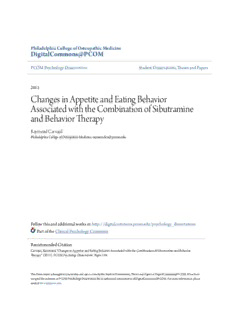Table Of ContentPhiladelphia College of Osteopathic Medicine
DigitalCommons@PCOM
PCOM Psychology Dissertations Student Dissertations, Theses and Papers
2011
Changes in Appetite and Eating Behavior
Associated with the Combination of Sibutramine
and Behavior Therapy
Raymond Carvajal
Philadelphia College of Osteopathic Medicine, [email protected]
Follow this and additional works at:http://digitalcommons.pcom.edu/psychology_dissertations
Part of theClinical Psychology Commons
Recommended Citation
Carvajal, Raymond, "Changes in Appetite and Eating Behavior Associated with the Combination of Sibutramine and Behavior
Therapy" (2011).PCOM Psychology Dissertations.Paper 194.
This Dissertation is brought to you for free and open access by the Student Dissertations, Theses and Papers at DigitalCommons@PCOM. It has been
accepted for inclusion in PCOM Psychology Dissertations by an authorized administrator of DigitalCommons@PCOM. For more information, please
[email protected].
Philadelphia College of Osteopathic Medicine
Department of Psychology
CHANGES IN APPETITE AND EATING BEHAVIOR ASSOCIATED WITH THE
COMBINATION OF SIBUTRAMINE AND BEHAVIOR THERAPY
By Raymond Carvajal
Submitted in Partial Fulfillment of the Requirements for the Degree of
Doctor of Psychology
PIllLADELPHIA COLLEGE OF OSTEOPATHIC MEDICINE
DEPARTMENT OF PSYCHOLOGY
Dissertation Approval
v4 -;r;;<? L-
This is to certify that the thesis presented to us by _____________
on the 3/ffday of __~_ _'. , 4_7__- __, 20 I( in partial fulfillment of the
requirements for the degree of Doctor of Psychology, has been examined and is
acceptable in both scholarship and literary quality.
Committee Members' Signatures:
Robert A. DiTomasso, Ph.D., ABPP, Chairperson
Stacey Cahn, Ph.D.
Thomas A. Wadden, Ph.D.
Robert A. DiTomasso, Ph.D., ABPP, Chair, Department of Psychology
iii
Acknowledgements
The original trial on which this study is based was completed with the support of grants
(DK56124 and DK065018) to Dr. Thomas A. Wadden from the National Institute of
Diabetes and Digestive and Kidney Diseases.
I would like to express my deepest gratitude to my committee members – Dr.
DiTomasso, Dr. Cahn, and Dr. Wadden – for their invaluable support, not only with
respect to the completion of this dissertation but also to my development as a clinical
psychologist. Your guidance and mentorship through the years will not be forgotten.
I would also like to thank Dr. Moore and Dr. Kral, who volunteered their precious time to
assist with the statistical analyses for this dissertation. Your help has been most
appreciated. Finally, words alone cannot express the thanks I owe to my family –
including my mother, father, brother, and beautiful wife, Terri – for their love, support,
and encouragement through the years. And to my wonderful children, thank you for
providing me inspiration each and every day.
iv
Abstract
This archival-data study assessed the potentially complementary mechanisms of action of
sibutramine and behavior therapy (also known as lifestyle modification) believed to be
responsible for the greater weight loss observed with combining the two approaches than
with either approach alone. One hundred and seventy-one subjects were randomly
assigned to receive 15 mg of sibutramine per day alone, delivered by a primary-care
provider in five brief office visits; behavior therapy alone, delivered by a psychologist in
18 group sessions; and sibutramine (15 mg/day) plus 18 group sessions of behavior
therapy (i.e., combined therapy). Mixed effects linear model analysis was used to
compare changes in scores among the groups on the Eating Behavior Inventory and on
visual analogue scales of appetite. Most of the findings were either significant or in the
expected direction. Subjects who received sibutramine alone and behavior therapy alone
displayed improvements principally in appetite control and eating behavior, respectively.
By comparison, those who received combined therapy displayed improvements in both
areas. These results provide evidence that sibutramine and behavior therapy work
additively to produce greater weight loss than either therapy alone. Furthermore, they
underscore the importance of prescribing weight loss medications in combination with
lifestyle modification, an approach that may be facilitated through the integration of
behavioral-health providers within primary care.
v
Table of Contents
List of Figures…………………………………………………………………………...viii
List of Tables……………………………………………………………………………..ix
Chapter One: Introduction………………………………………………………………...1
Statement of the Problem………………………………………………………….1
Purpose of the Study………………………………………………………………3
Relevance to Cognitive Behavior Therapy…...….………………………………..4
Chapter Two: Literature Review………………………………………………………….7
Definition of Obesity……………………………………………………………...7
Prevalence of Obesity……………………………………………………………..8
Etiology of Obesity..……………………………………………………………..10
Genetic Factors…………………………………………………………..10
Environmental Factors………………………………………………...…12
Psychological Factors……………………………………………………15
Obesity-Related Comorbidities…………………………………………………..16
Medical Comorbidities………………………………………………...…16
Psychosocial Comorbidities……………………………………………...18
Treatment Approaches……………………………………………………….…..22
Behavior Therapy………………………………………………………...23
Pharmacotherapy………………………………………………………....34
Surgical Treatments……………………………………………………...38
Combination of Pharmacotherapy and Behavior Therapy……………….39
vi
Chapter Three: Hypotheses………………………………………………………………45
Overall Question…………………………………………………………45
Hypothesis 1…………………………………………………...…………45
Ho………………………………………………………...………45
H …………………………………………………………...……45
1
Rationale…………………………………………………………45
Hypothesis 2…………………………………………………………...…46
Ho………………………………………………………...………46
H …………………………………………………………...……46
1
Rationale…………………………………………………………46
Chapter Four: Methods………………………...………………………………………...47
Design and Design Justification………………………………………….47
Participants……………………………………………………………….47
Inclusion/Exclusion Criteria…………………………………………..…48
Screening Procedures to Determine Inclusion/Exclusion Criteria…….…48
Recruitment……………………………………………………………....49
Plan for Informed Consent Procedures…………………………………..49
Measures……………………………………………………………........49
Eating behavior……….………………………………………….49
Appetite……….………..………………………………………...50
Procedure………………………………………………………………...52
Analysis of Risk/Benefit Ratio…………………………………………..52
vii
Potential risk to participants……………………………..…….…52
Potential benefit to participants……………………………….…52
Potential benefit to others……………………………….…….…52
Procedure for Maintaining Confidentiality……………………………....53
Chapter Five: Results……………………………………………………………….........54
Statistical Analyses………………………………………………………54
Eating Behavior………………………………………………………….57
Appetite…………………………………………………………………..57
Food preoccupation……………………………………….……...57
Cravings………………………………………………………….61
Satiation………………………………………………………….63
Hunger……………………………………………………………63
Chapter Six: Discussion………………………………………………………………….64
References………………………………………………………………………………..86
Appendix A: Eating Behavior Inventory……………………………………………….118
Appendix B: Visual Analogue Scales…………………………………………………..120
viii
List of Figures
Figure 1. Mean changes in weight (kg)……………...…………………………………..66
Figure 2. Mean changes (mm) in food preoccupation…………………………………...68
Figure 3. Mean changes (mm) in cravings………………………………………………69
Figure 4. Mean changes (mm) in satiation………………………………………………70
Figure 5. Mean changes (mm) in hunger………………………………………………...72
ix
List of Tables
Table 1. Baseline Characteristics of Subjects…………...……………………………….55
Table 2. Correlations of Appetite Ratings……………………………………………….56
Table 3. Eating Behavior Inventory Scores……………………………………………...58
Table 4. Changes in Appetite…………………………………………………………….59
Description:displayed improvements principally in appetite control and eating behavior, has been termed a “normative discontent” (Rodin, Silberstein, & Striegel-Moore, 1985) providing patients with calorie-specific menus, recipes that use Low-carbohydrate diets, such as the Atkins diet (Atkins, 1998),.

